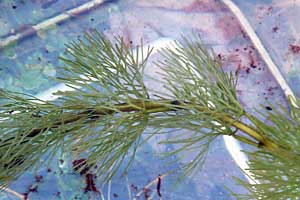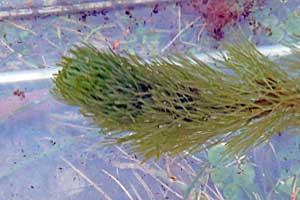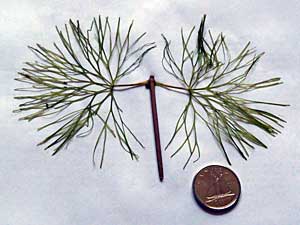An Invasive Aquatic Plant in |
|
We ruled out Eurasian Water-Milfoil (Myriophyllum spicatum), which does not have a fan like leaf. Finally, an internet search for aquatic plants turned up a drawing of Fanwort (Cabomba caroliniana) that matched the specimens opposite arrangement of leaves, and its leaf with a distinct petiole and fan-like spread quite nicely. At this point, I asked for input from the larger naturalist community in Nova Scotia, and Nicolas Hill confirmed that the specimen was indeed a Fanwort. Furthermore, he stated that this would be the first record of Cabomba in the Maritime provinces.
Checking with people familiar with Frog Pond provided another piece of information: A fellow naturalist reported seeing but not formally identifying this plant in Frog Pond five years ago, and saw it growing densely in the narrows of Frog Pond this summer (2014).
While it is normally exciting to find a new species, in this case it is not so. Native to South America and maybe the southern United States, it has been introduced to other parts of the world (Australia, Ontario*).
In its non-native range, fanwort is considered an unwanted species that easily spreads even by small parts of its stems, and potentially disrupts native flora and fauna. Fortunately, Frog Pond drains into the ocean, eliminating the possibility of a downstream spread of Fanwort. People living in the neighbourhood have reported seeing similar plant growth in Whimsical Lake, which is upstream from Frog Pond. Unfortunately, verification of the plant species will have to wait until the ice on the lake has melted.
Eradication of Fanwort appears near impossible. Thus, further spreading should be prevented by educating visitors to the pond. In general, disposal of foreign specimens into the wild are potentially harmful, and better public knowledge appears desirable. Selecting only plants for aquariums that cannot survive in our lakes and rivers, would eliminate the possibility of accidentally introducing plants.
*See http://www.invadingspecies.com/invaders/plants-aquatic/fanwort/
UPDATE: Sep 13, 2015 This past December, I had reported finding Fanwort (Cabomba caroliniana) at the Frog Pond in the Dingle Park, Halifax.
Over the summer, I noticed it growing around most of the edge of the pond, but it was hard to see how far it was growing towards the center.
Now, its small white flowers are emerging above the water surface, making it easy to see the extent. In my estimate, 1/4 to 1/3 of the surface is covered by Fanwort, generally in the shallow or protected areas. As far as I recall, some of those areas were occupied by Water Lilies in previous years. Water Lilies are a food source of beavers, which have been on the pond in the past. Not this year, however. Maybe chance, maybe they don't like to swim in a tangle of Fanwort (I would not want to), or some other reason.
I had also speculated about Fanwort in Whimsical Lake, which is upstream from Frog Pond. However, a few weeks ago, I did not see any, but was pleased to find some bladderwort (Utricularia sp.).
-Burkhard Plache


